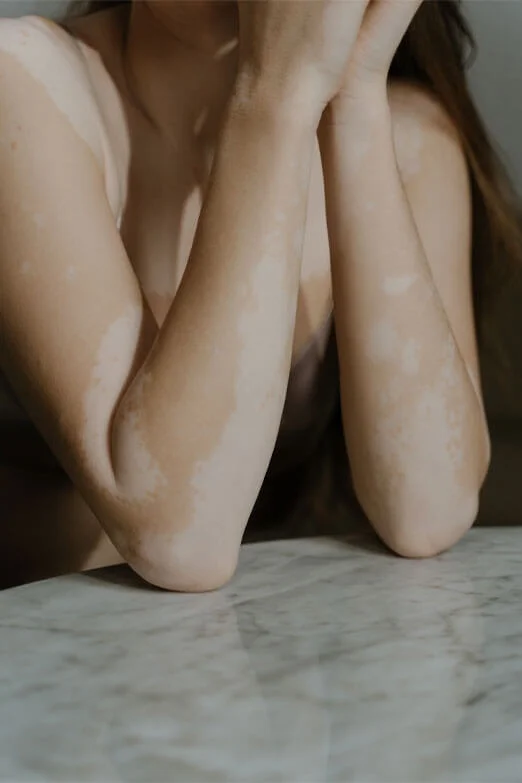Best Vitiligo Treatment Options in Bangalore
Many remedies can help minimize the visibility of the condition but do not cure vitiligo. These include
1. UVB Phototherapy
It is a common treatment for vitiligo provided at Charma Clinic by expert Vitiligo Doctors in Bangalore. Ultraviolet B light produced from UVB broadband is focused on the skin for a specific time to avoid overexposure. This treatment session can be carried out in a clinic 2-3 times a week or daily at home using a small UVB light-emitting lamp. If combined with other topical treatments, it can more effectively reduce the white patches on the skin and improve re-pigmentation. Charma clinic has one of the best targeted phototherapy lasers which is a type of UVB phototherapy. It gives results in patients who might have failed treatment with regular narrow band UVB treatment.
2. UVA Phototherapy
UVA light can stop or slow the progression of vitiligo. UVA (Ultraviolet A light) and psoralen treatment involve taking medication, to begin with, which helps in enhancing the skin's sensitivity to UV light. It also exposes the skin to high doses of UVA light. This treatment is considered very effective for people with white patches in the neck, head, upper arms, trunk, and legs. A series of twice-weekly treatment sessions shall be conducted in a healthcare setting for about 6-12 months or even longer to improve the condition significantly. To get UVA phototherapy Vitiligo Skin Treatment in Bangalore, consult with a dermatologists at Charma Clinic. UVA treatment can cause dark repigmentation which is much darker than the normal skin tone of the patient. Hence, it is not a popular treatment these days. Psoralens are also known to be toxic to the liver and should be avoided as far as possible.
3. Skin Camouflage
Mild vitiligo can be covered with makeup or other topical cosmetic camouflage solutions according to the tone that matches the natural skin color. Such camouflage creams help blend the white patches with the rest of the skin to go unnoticed. Sunscreen (i.eSPF 30 or above) shall also be applied to shield the skin from UVA and UVB light and prevent uneven tanning and hyperpigmentation.
4. Immune Modulators
Topical preparations of immune-suppressing medications, including calcineurin inhibitors and glucocorticoids, are considered the first line vitiligo treatment and can help with smaller patches of depigmentation.
5. Ultrathin Epidermal Grafting
It is a specialized type of skin grafting. Vitiligo surgery in Bangalore is performed for people with small patches of vitiligo. In this treatment, the skin doctor at Charma Clinic takes a small section of the skin from the healthy pigmented area of the patient's skin and attaches it to the affected area of the skin that has significant loss of its pigments.
6. Suction Blister Grafting
It is another option available to help even out the skin tone. In this procedure, the skin doctor creates blisters on the patient's pigmented skin using suction. In the next step, the doctor transplants the top portion of the blisters to the discolored skin area to match the rest of the skin color. The cost of vitiligo surgery in Bangalore depends on the target body area, the number of grafts transplanted, patient age, doctor experience, and several other factors. Consult with the expert skin doctors at Charma Clinic, the best skin clinic in Bangalore, to know more about cost.
7. Topical Medications
A potent or super-potent corticosteroid is a commonly prescribed topical medication that can be applied to the white patches on the skin. It may also be combined with another medication like a form of Vitamin D to improve results. Corticosteroids work best for dark-pigmented or tanned skin that possesses widespread areas of vitiligo.
8. Tattooing
This treatment involves the placing of new pigments into the areas of blotchy skin. It is an effective technique that shall be repeated every few years to maintain the natural-looking skin color as the pigments may fade away with time. It is the last resort when no other treatments are working as the colour of tattoo ink may not match the patient's skin tone and fades with time.
9. De-pigmentation
Depigmenting the unaffected skin with topical ointments or lotions can be the best option when the affected area is widespread, covering 50% of the body. The topical solutions may comprise certain solutions which can render the skin an even color. It is a vigorous method that may leave the skin more fragile. Hence, protection from the sun throughout life is very important to avoid severe sunburn and melanomas. Depigmentation may take about a year to complete, and the time to visualize the results may vary based on factors like the depth of the normal skin tone.


